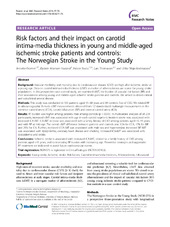| dc.contributor.author | Fromm, Annette | en_US |
| dc.contributor.author | Haaland, Øystein Ariansen | en_US |
| dc.contributor.author | Næss, Halvor | en_US |
| dc.contributor.author | Thomassen, Lars | en_US |
| dc.contributor.author | Waje-Andreassen, Ulrike | en_US |
| dc.date.accessioned | 2014-10-07T13:34:50Z | |
| dc.date.available | 2014-10-07T13:34:50Z | |
| dc.date.issued | 2014-03-26 | eng |
| dc.identifier.issn | 1756-0500 | |
| dc.identifier.uri | https://hdl.handle.net/1956/8603 | |
| dc.description.abstract | Background: Vascular morbidity and mortality due to cardiovascular disease (CVD) are high after ischemic stroke at a young age. Data on carotid intima-media thickness (cIMT) as marker of atherosclerosis are scarce for young stroke populations. In this prospective case–control study, we examined cIMT, the burden of vascular risk factors (RF) and their associations among young and middle-aged ischemic stroke patients and controls. We aimed to detect clinical and sub-clinical arterial disease. Methods: This study was conducted in 150 patients aged 15–60 years and 84 controls free of CVD. We related RF to ultrasonographic B-mode cIMT-measurements obtained from 12 standardized multiangle measurements in the common carotid artery (CCA), carotid bifurcation (BIF) and internal carotid artery (ICA). Results: RF burden was higher among patients than among controls (p < 0.001). In multivariate analyses of all 234 participants, increased cIMT was associated with age in each carotid segment. Incident stroke was associated with increased ICA-IMT. ICA-IMT increase was associated with a family history of CVD among patients aged 15–44 years, and with RF at mid-age. The overall cIMT difference between patients and controls was 12% for CCA, 17% for BIF and 29% for ICA. Further, increased CCA-IMT was associated with male sex and hypertension. Increased BIF-IMT was associated with dyslipidemia, coronary heart disease and smoking. Increased ICA-IMT was associated with dyslipidemia and stroke. Conclusions: Ischemic stroke is associated with increased ICA-IMT, related to a family history of CVD among patients aged <45 years, and to increasing RF burden with increasing age. Preventive strategies and aggressive RF treatment are indicated to avoid future cardiovascular events. | en_US |
| dc.language.iso | eng | eng |
| dc.publisher | BioMed Central | eng |
| dc.relation.ispartof | <a href="http://hdl.handle.net/1956/12326" target="blank">Ischemic stroke and atherosclerosis at a young age. The Norwegian Stroke in the Young Study</a> | |
| dc.rights | Attribution CC BY | eng |
| dc.rights.uri | http://creativecommons.org/licenses/by/4.0 | eng |
| dc.subject | Young stroke | eng |
| dc.subject | Ischemic stroke | eng |
| dc.subject | Risk factors | eng |
| dc.subject | Carotid intima-media thickness | eng |
| dc.subject | Atherosclerosis | eng |
| dc.subject | Ultrasound | eng |
| dc.title | Risk factors and their impact on carotid intima-media thickness in young and middle-aged ischemic stroke patients and controls: The Norwegian Stroke in the Young Study | en_US |
| dc.type | Peer reviewed | |
| dc.type | Journal article | |
| dc.date.updated | 2014-04-22T03:32:14Z | |
| dc.description.version | publishedVersion | en_US |
| dc.rights.holder | Annette Fromm et al.; licensee BioMed Central Ltd. | |
| dc.rights.holder | Copyright 2014 Fromm et al.; licensee BioMed Central Ltd. | |
| dc.source.articlenumber | 176 | |
| dc.identifier.doi | https://doi.org/10.1186/1756-0500-7-176 | |
| dc.identifier.cristin | 1162263 | |
| dc.source.journal | BMC Research Notes | |
| dc.source.40 | 7 | |

